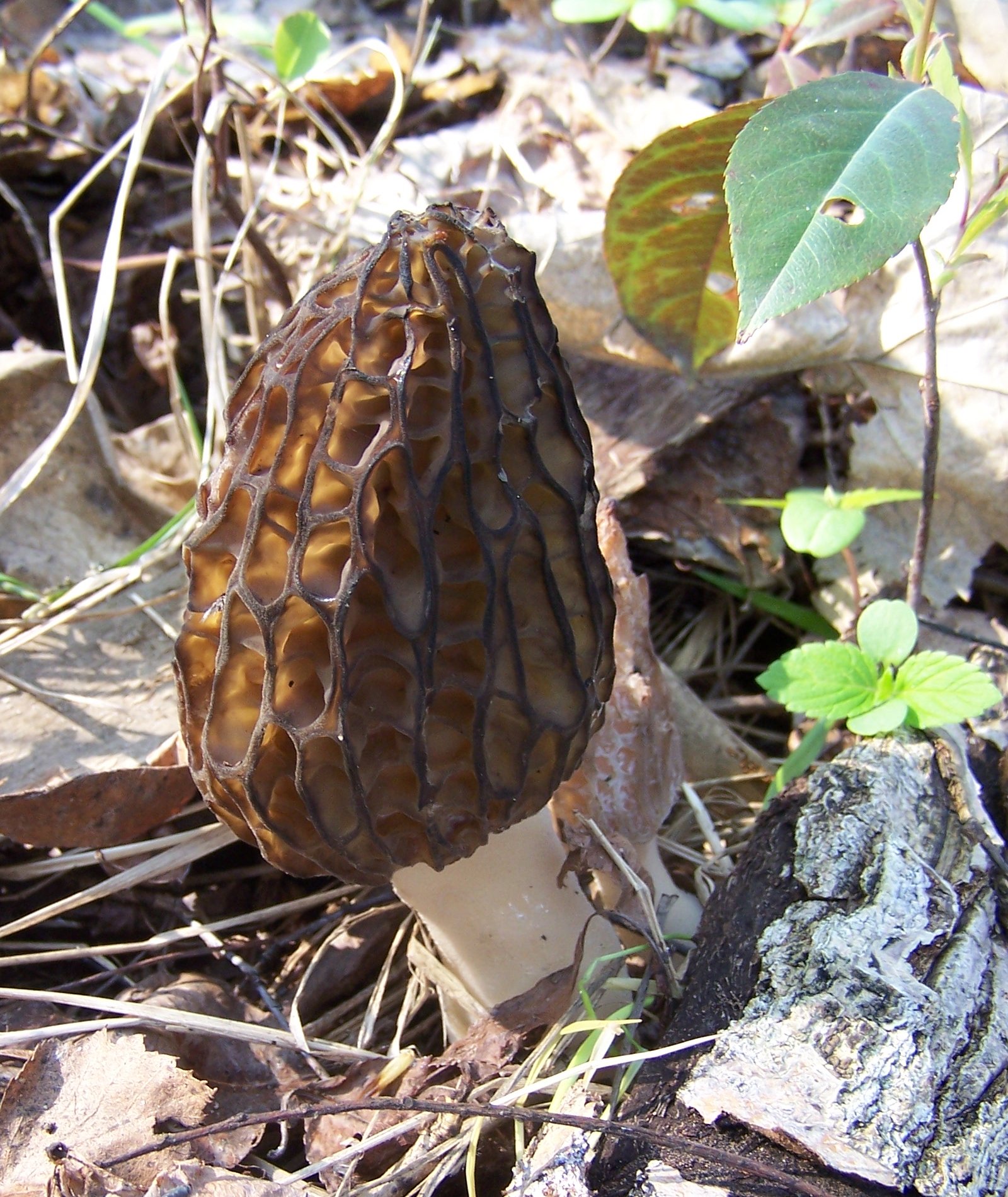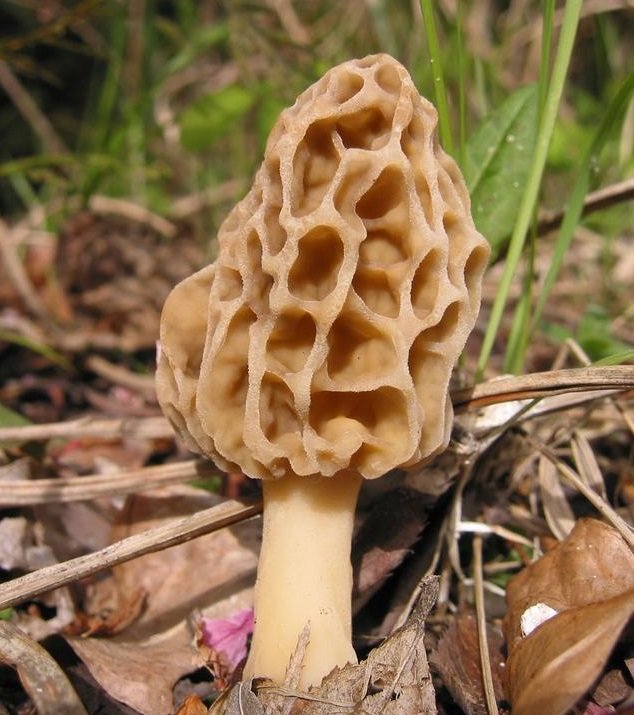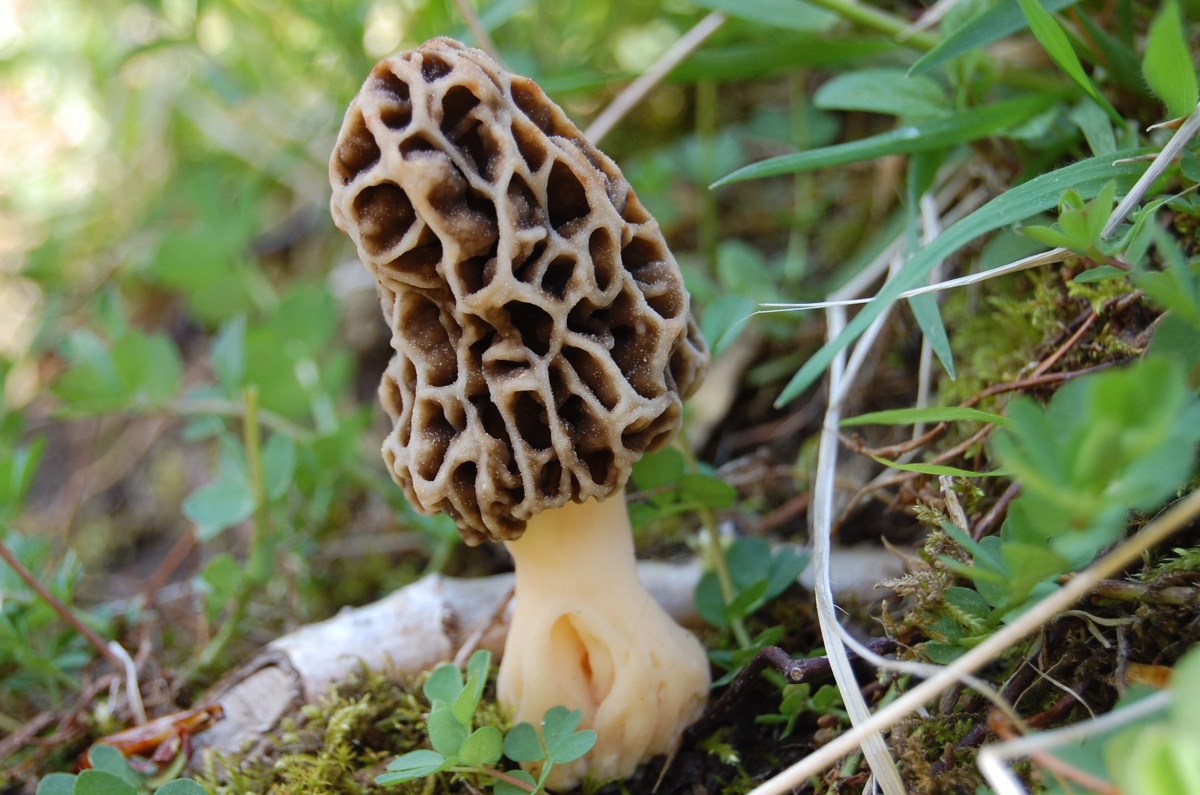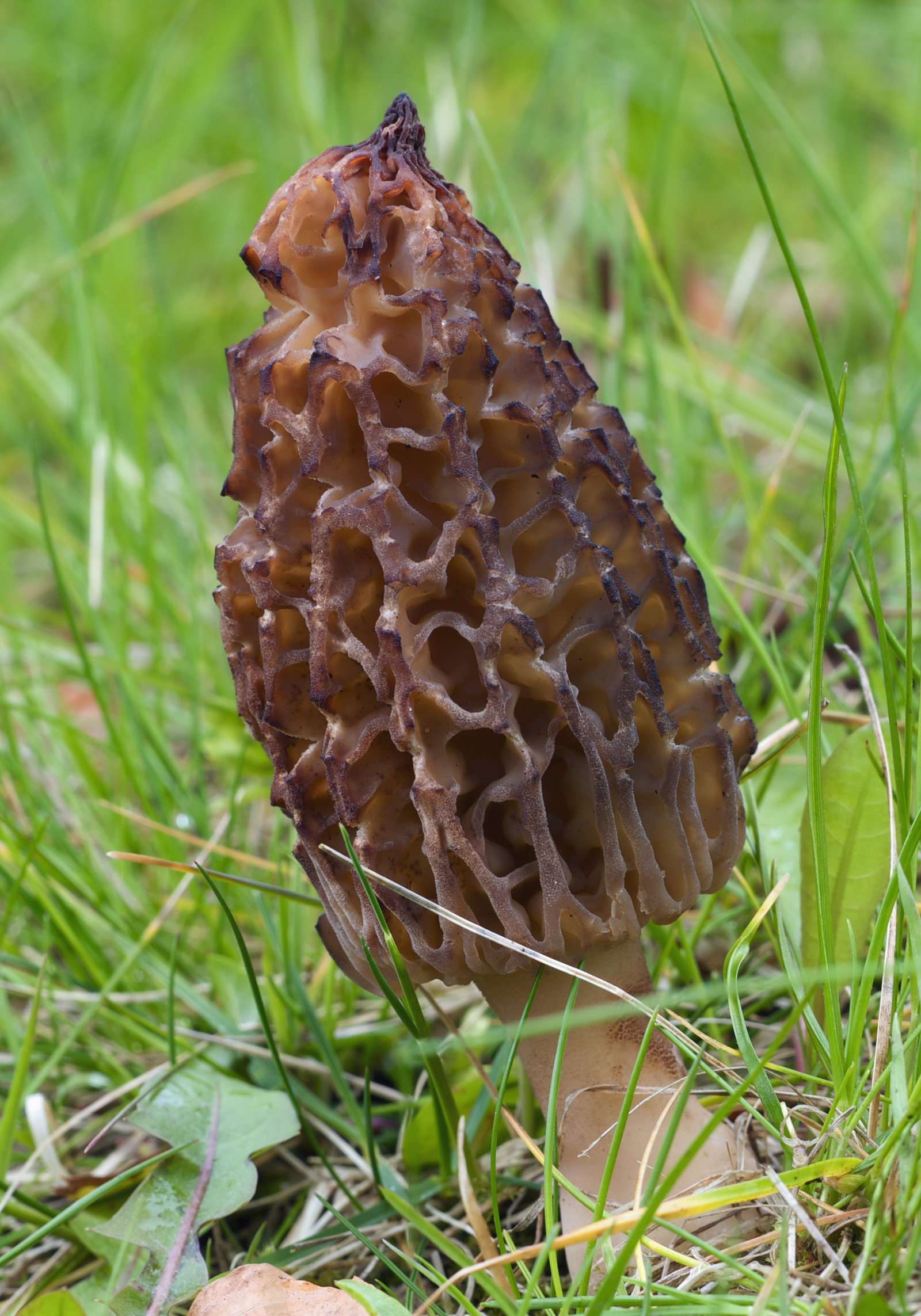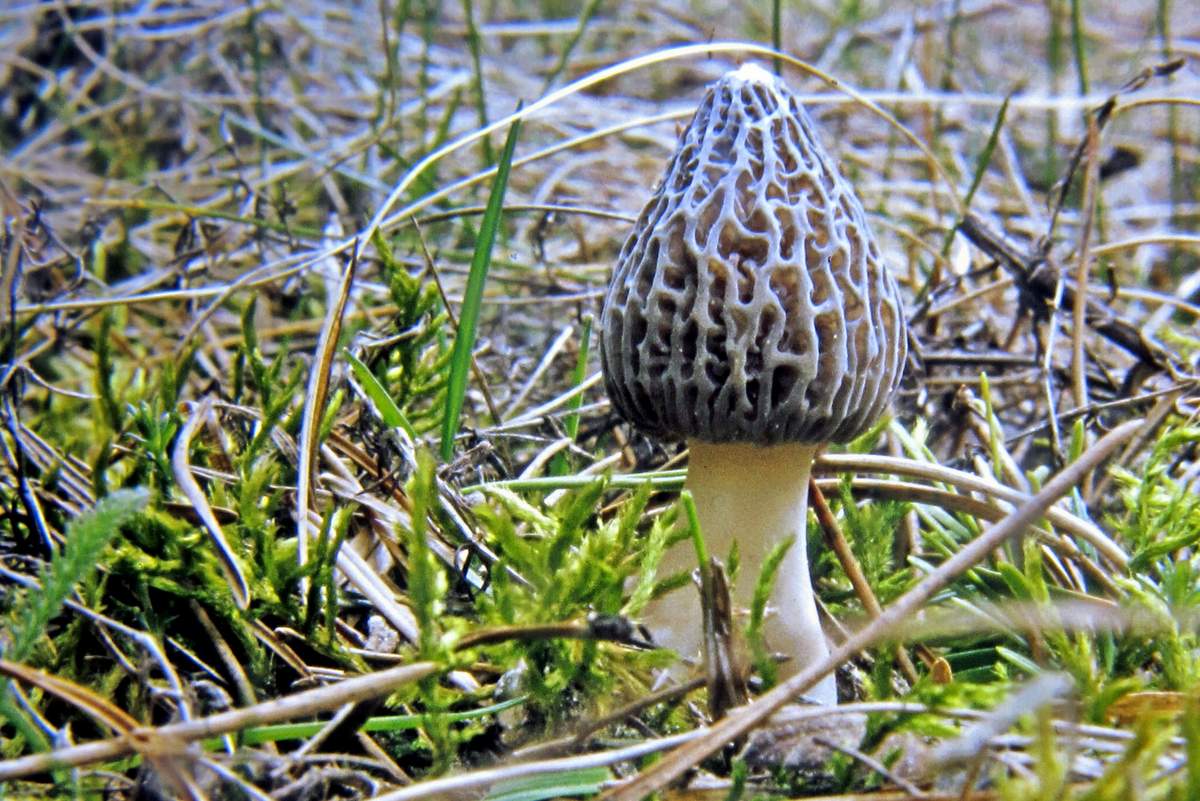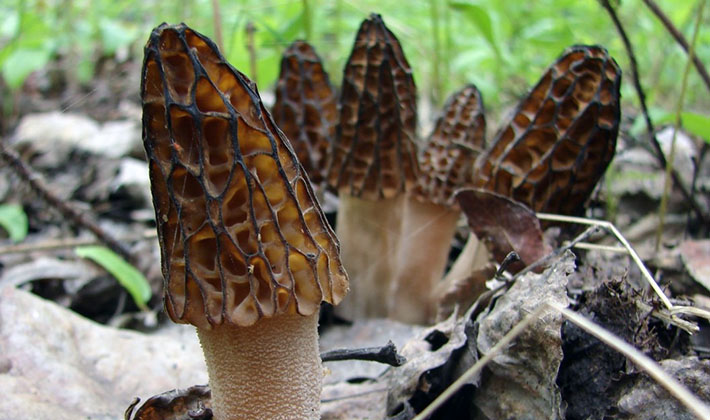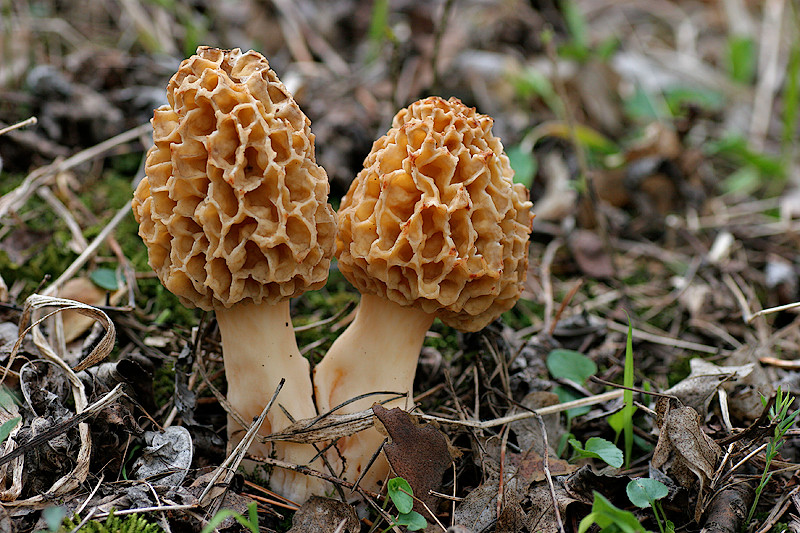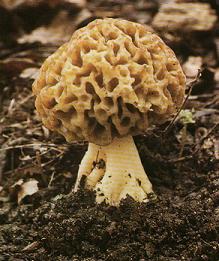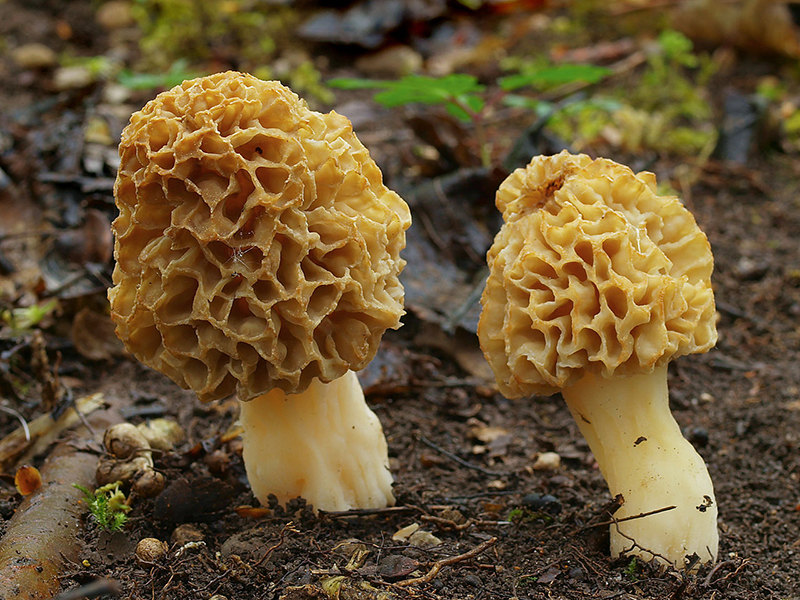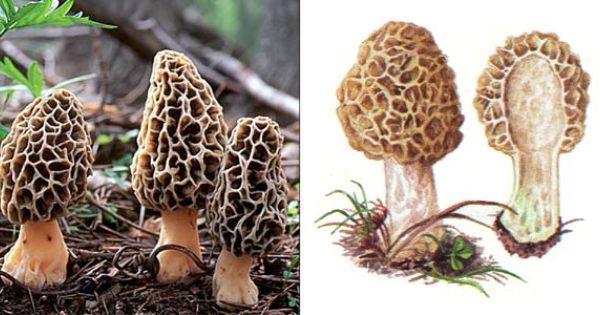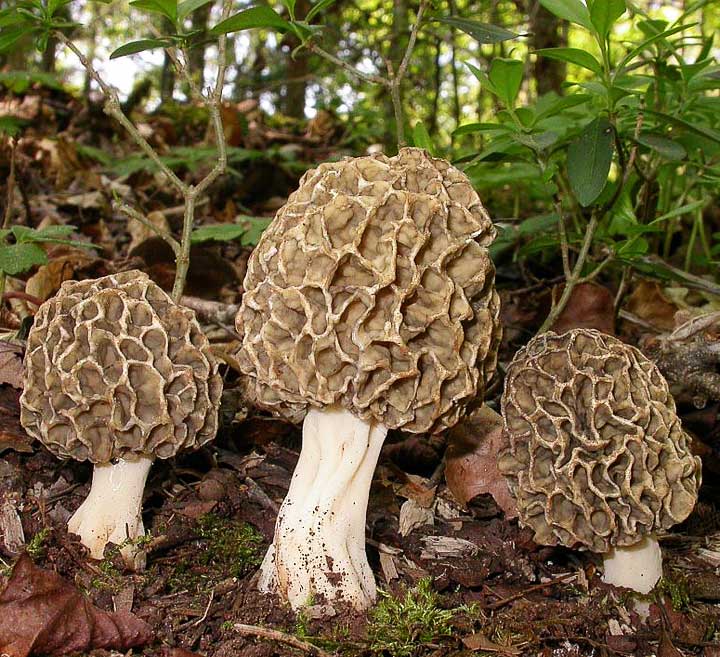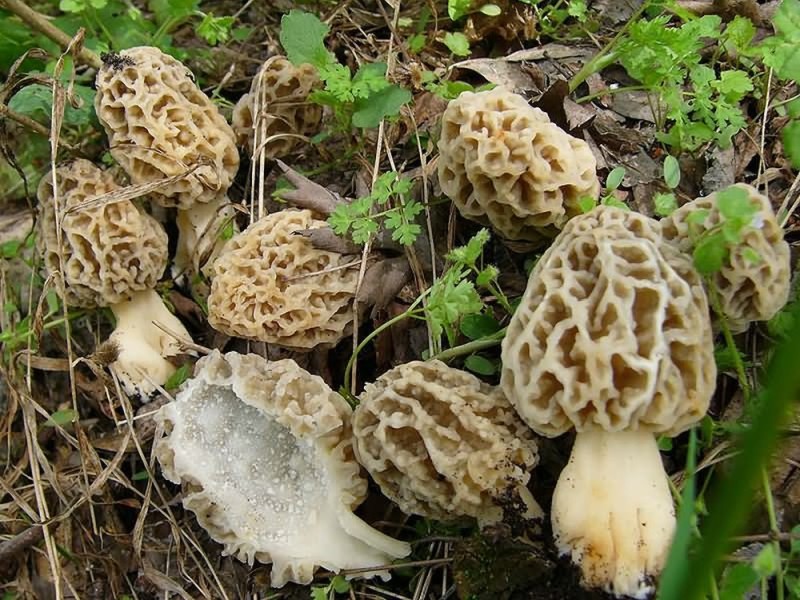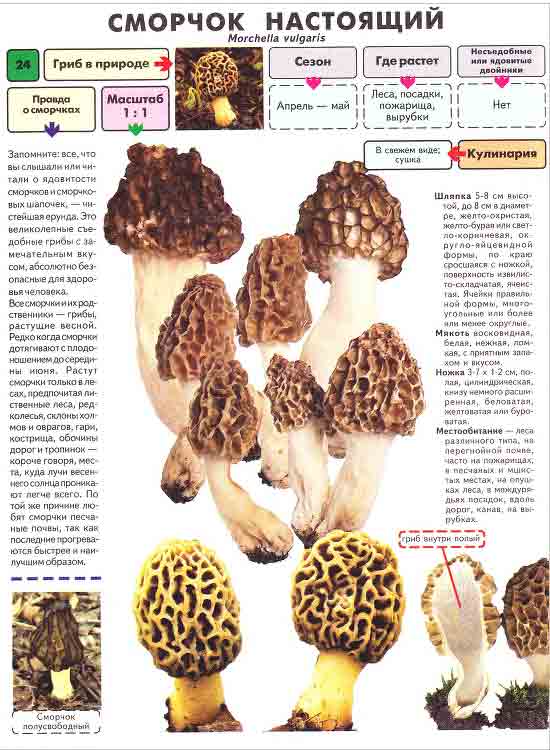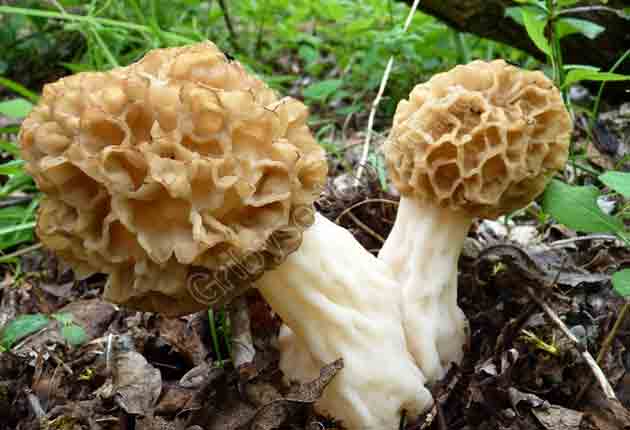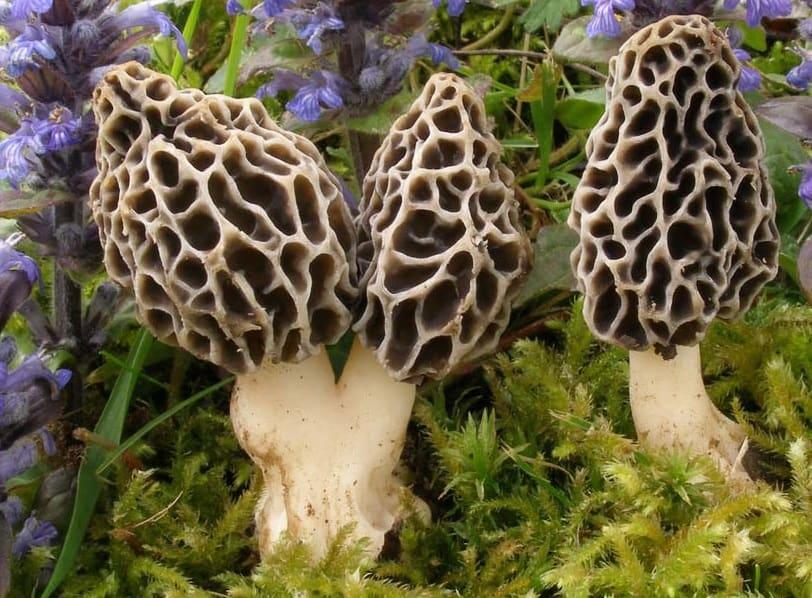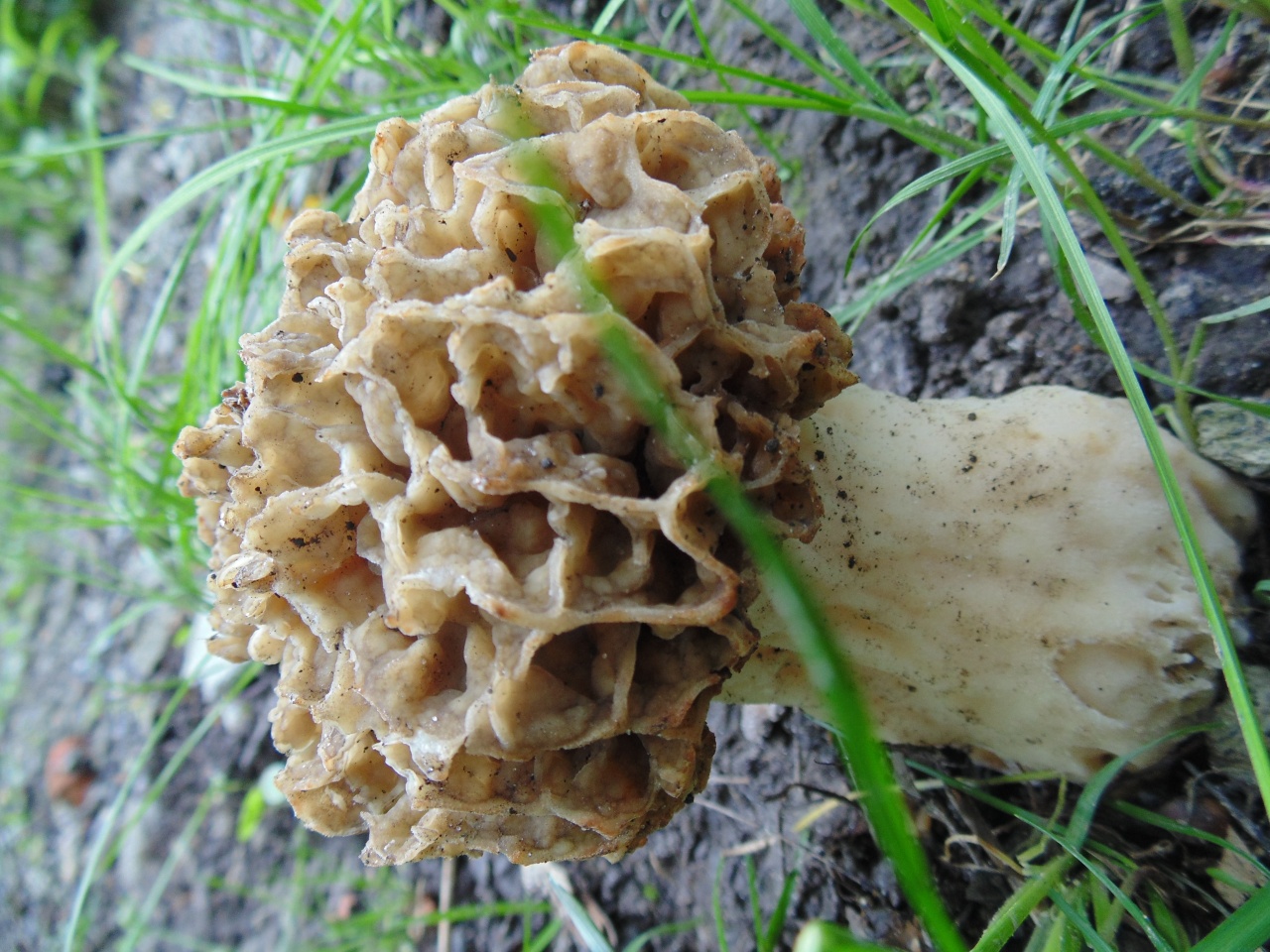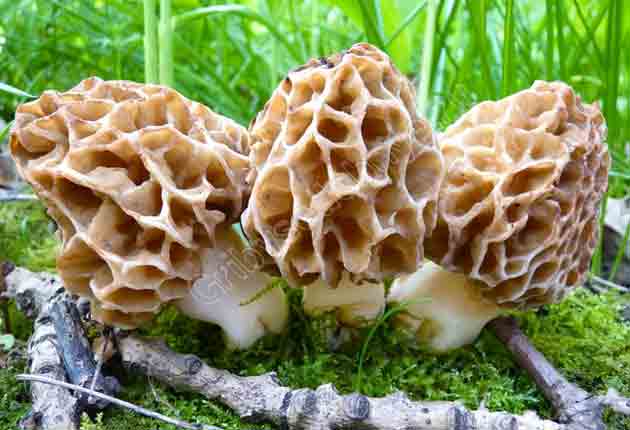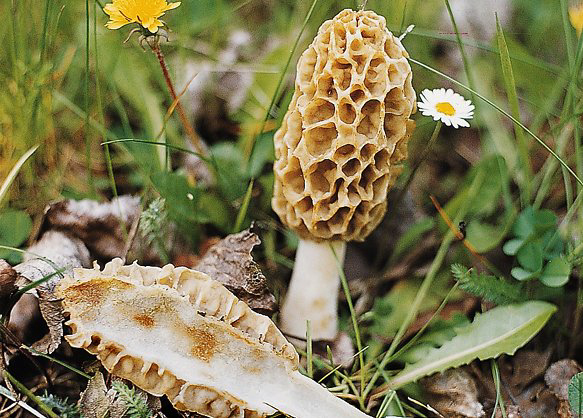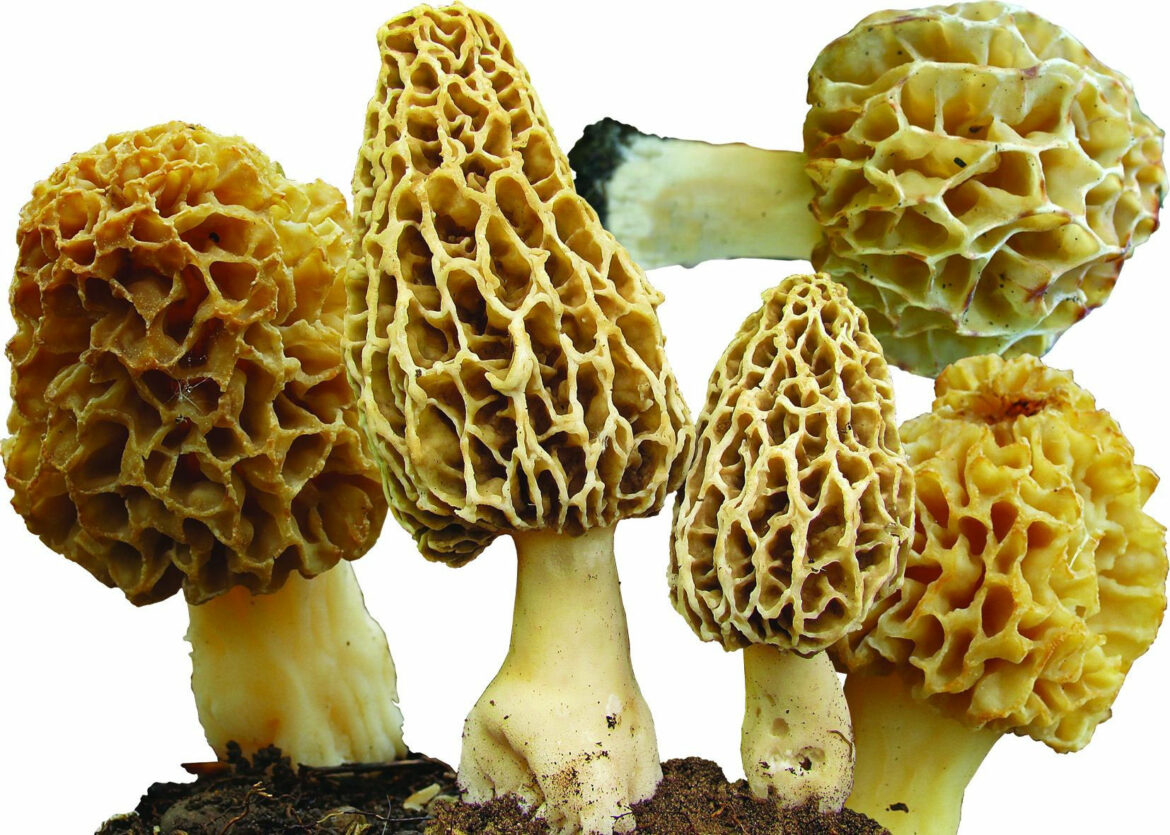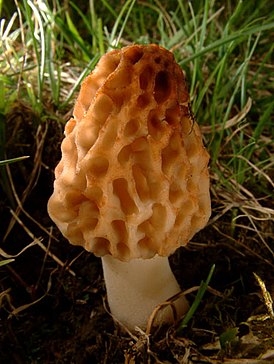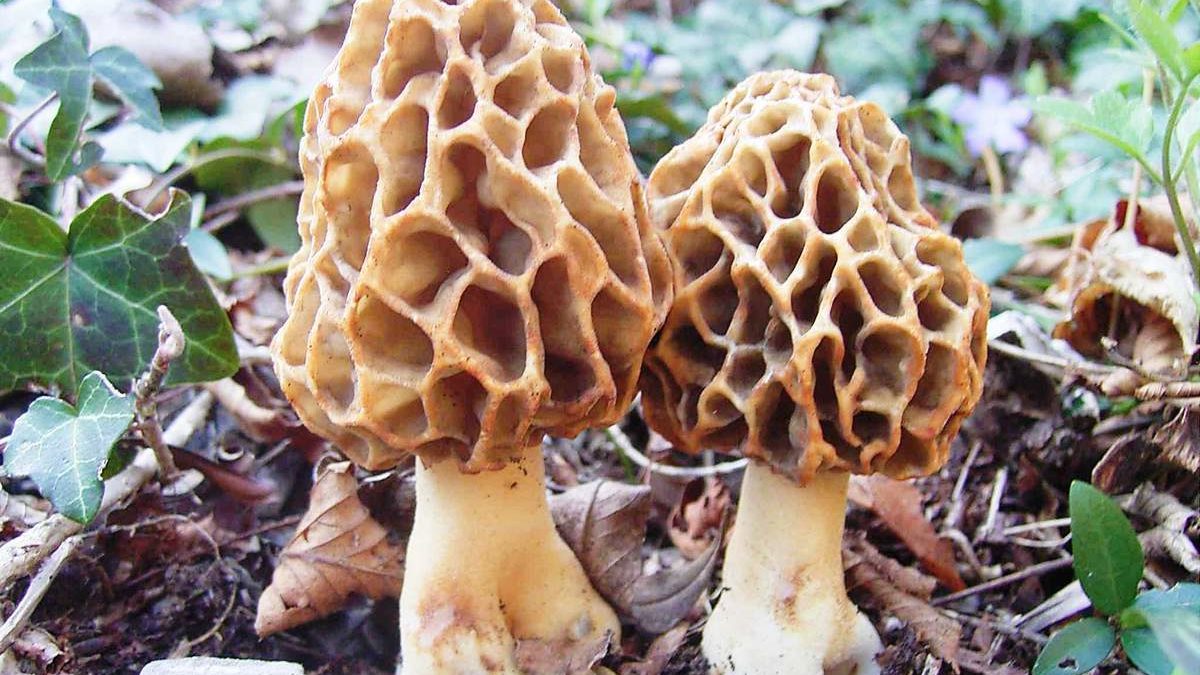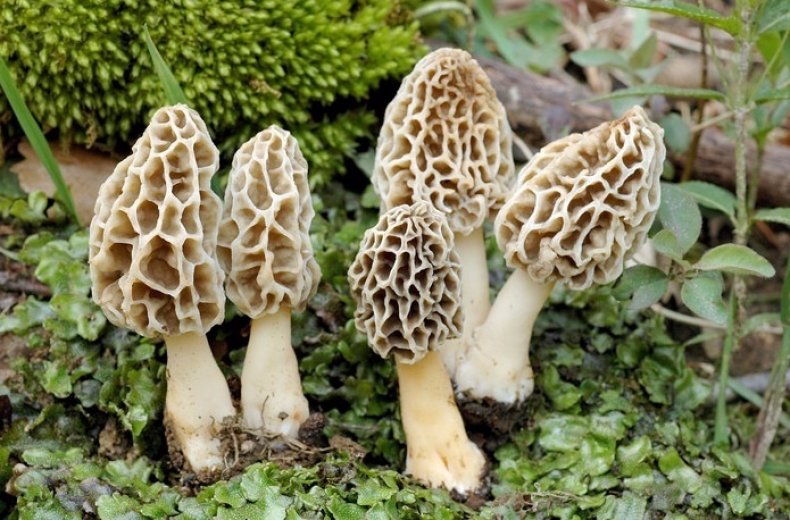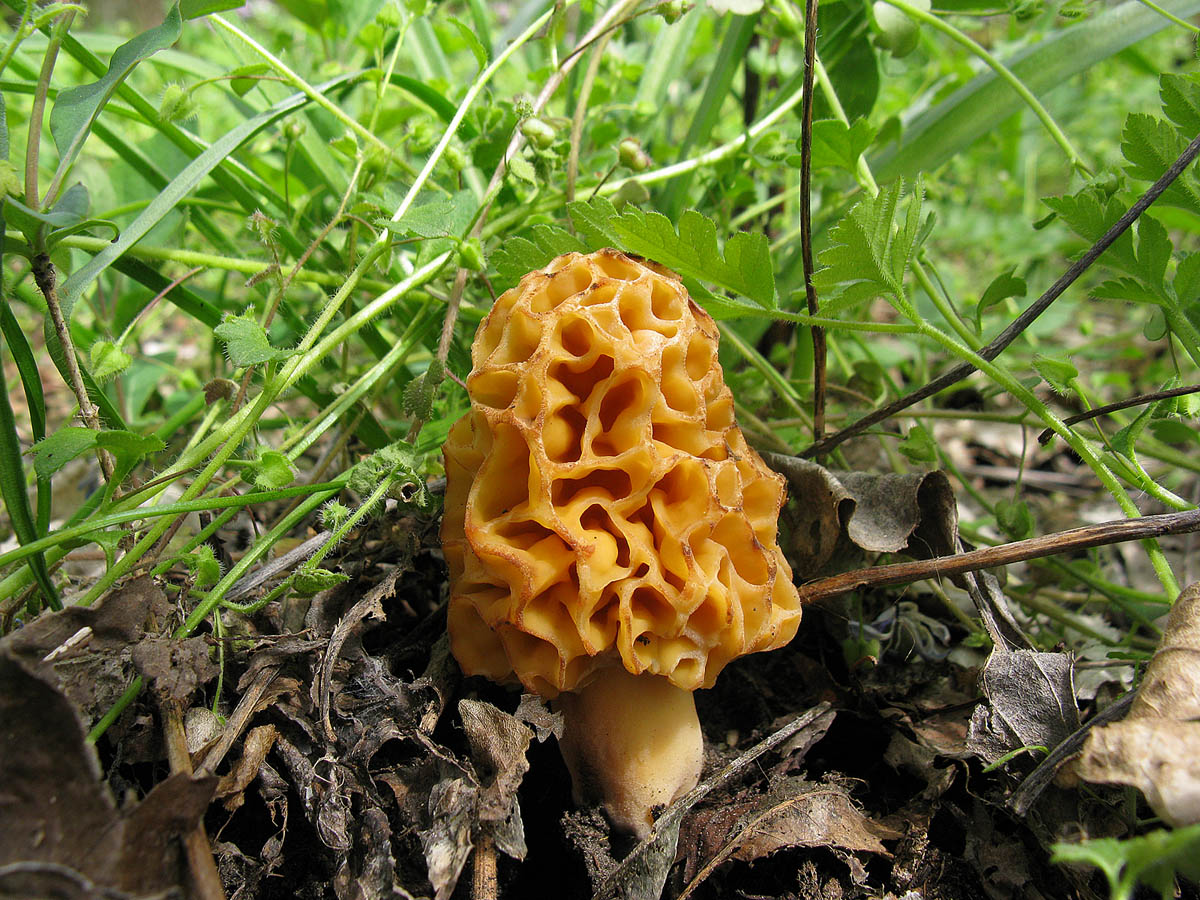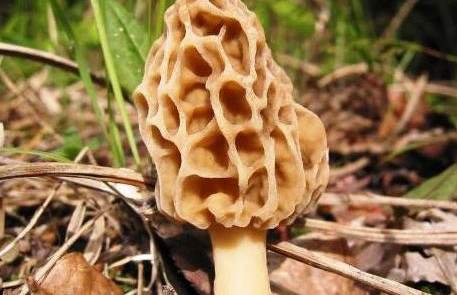Stitching Plain Gyromitra esculenta
Stitching Plain Gyromitra esculenta
A great friend of especially reckless mushroom pickers. Belongs to the species of marsupial mushrooms of the Strochok genus, the Discinovye family. Its scientific name is quite curious, it is a mixture of Greek and Latin, meaning "round edible headband." In English-speaking countries, it is called "mushroom-brain" - all because of its characteristic shape.
It grows in April and May on sandy soils, places of former forest fires, areas of deforestation. Mostly found under conifers, likes to grow next to poplars.
Appearance
The cap is visually similar to the human brain, up to 10 cm high and up to 15 cm wide. In young specimens, it is smooth, and becomes wrinkled with aging. The color of the cap is usually brown, but mushrooms are found with purple, red and orange coloration.
The leg is 2 to 3 long and 2 to 6 cm in diameter, hollow inside, of a light shade, sometimes with pinkish notes. It tapers towards the base and is firm to the touch.
The pulp is thin, waxy with a very pleasant, slightly fruity odor and not bad taste.
Is it worth it?
Dangers of Eating Lines
For a long time, there has been a debate among mushroom pickers about whether it is dangerous or not to eat lines in food. On the one hand, their very Latin name implies that they are edible. Stitches are also growing in Europe and North America, and have been used there for hundreds of years. However, it is scientifically proven that these mushrooms contain the carcinogenic toxin gyromitrin, which negatively affects the liver, gastrointestinal tract and the autonomic nervous system. Gyromitrin in the body is metabolized with the elimination of the formyl group and aldehyde, forming toxic methylhydrazine.
There are two ways to detoxify stitches:
- Boil for half an hour, drain the broth and rinse the mushrooms with running water - methylhydrazine will leave with the broth. Can be boiled twice in a row.
- Dry for a long time in the open air - methylhydrazine will evaporate.
But the toxins will completely leave the lines only if they are dried outside in the sun for at least six months, which in Russian natural conditions is simply unrealistic. These toxins also may not cause a clinical picture of poisoning, but slowly accumulate in the body. There is a theory that the strains of gyromitrin in the composition of the lines may differ, and some of them are not destroyed by digestion.
Experienced mushroom pickers say that everything here depends on the degree of poison content in each specific mushroom and the individual characteristics of the eater. You can chew a raw line without any consequences, or you can be seriously poisoned by those that have been washed and boiled for many hours. Here everyone decides for himself whether he is ready to risk his health.
Where do morels grow?
They grow in any forest. At the same time, different species prefer certain trees, for example:
- Conical morel, more often found in pine forests, less often in deciduous forests. Prefers felling, shrubs, willows, but can grow in the garden, in the field.
- The gray giant morel is not so whimsical to soil and terrain - it even settles in clay wastelands. It is found in poplar groves and in shelter belts.
- Morel cap. Avoids shadows. In early May, it grows in burnt-out areas, glades, near roads.
Growing conditions:
- They love moisture. At high humidity, they grow even in a treeless desert.
- In early spring, when the soil is moist, the mushroom grows in almost any conditions - you can even find it in your own garden or vineyard.
- If you go for a massive harvest of morels, then it is better to look for them in well-lit glades and on scorched terrain.
In good weather, when it is warm and damp, the harvests are enormous. But few people go in the spring for mushrooms. Therefore, morel families often remain intact.Why aren't they collected? Perhaps due to the fact that they are not outwardly attractive, they grow out of season, and most importantly, many are afraid of poisoning. But if you look at the external signs, then it is unrealistic to confuse edible morels with dangerous lines.
A lover of "quiet hunting" tells how the lines differ from morels, how they grow, and how to look for them:
Varieties of morels from the photo, are they poisonous?
Unfortunately, the lines and morels differ not only externally, but also internally. The first - it is categorically impossible to use because of the content of poison in the pulp, which is dangerous to the body. The second - can and should be used as food, after heat treatment. Varieties of morels are both edible and conditionally edible species that are acceptable for consumption.
No. 1 - common morel
The classic representative of its species is Morchella esculenta or morel. Its distinctive feature, for many years, has been the fusion of the cap with the stem. A single form distinguishes him from his fellows.
Outwardly, the cap is ovoid, elongated, with cells of varying depth. The leg is light, closer to a snow-white shade, it can reach up to 12 cm in length. Hat - painted in any shades of yellow or brown, from light to dark.
Of the pests found during the germination of the mycelium, slugs and other crawling insects, hiding in the pulp of the cap, are activated. To prevent them from entering food, after harvesting, the mushrooms are washed and soaked in salt water for one hour. The procedure eliminates not only pests, but also dirt adhering to the germination period.
No. 2 - conical morel
Morchella conica remains a species of the morel family found in humid areas. The conical shape, uniting the cap and the leg, was transferred to the name of the species. Morel is conical, stands out on the ground for the following differences:
a hollow, but cellular cap, having a pointed shape, reaching a length of up to 10 cm, not counting the legs. Usually, the top is larger than the bottom. The color scheme is light yellow, with a slight tint to a brown tone. In rare cases, it can be colored to dark brown;
leg - cylindrical, empty inside. The height is small, in rare cases it reaches 6 cm. The diameter does not exceed 1.5 cm. Externally, it is covered with velvet dusting and longitudinal grooves. The color range is white, less often light yellow.
No. 3 - high morel
A large morel, similar to a conical one, has the unusual name Morchella elata. Translated into Russian, it is characterized as high. The difference between the species remains the dark shade of the cap and the large, one might even say high fruiting body. The length of the "high" reaches up to 35 cm.
The hat resembles a cone, reaching a length of up to 12 cm, and a diameter of no more than 2.5. Deep cells can be seen on the top of the mushroom. The color scheme is red, less often brown with a black tint. The partitions between the cells are expressive, differing in color from the fruit itself. Often, they have an olive-reddish tone.
The leg is high, slightly larger than the cap. It can be of an elongated form of white, no more than 16 cm. In adult mushrooms, it can be darker, - from cream to light coffee shade.
No. 4 - steppe morel
The name speaks for itself! Morchella steppicola or in common people - the largest morel (photo below), is found almost throughout Russia. It can be found in April and May on vast steppes, fields, marshlands and even forest belts where moss sprouting is observed.
The hat is similar in roundness to the stitching, but has a soft cream shade. In width and height it can reach up to 25 cm.
The leg is of snow-white tones, short and empty. Height in rare cases reaches 2.5 cm.
In order not to confuse the steppe morel with a line that is poisonous or conditionally edible, it is recommended to navigate not only by signs, but also by a visual photo. With a correct visual assessment of the differences, even a beginner will be able to identify an edible mushroom from a prohibited, not recommended for collection.
Primary processing and cooking recipes
Primary processing of morels is reduced to boiling cut mushrooms (the lower part of the stem is removed) for 10-15 minutes in salted water, which is then drained. If in doubt or with a large number of mushrooms, the procedure is carried out twice, then rinsed under running water. Mushrooms processed in this way are used in the preparation of various dishes.
It is allowed to dry cut morels for 3-4 months until completely dry. Dry morels are stored in boxes or paper bags away from moisture. Powder is prepared from dried mushrooms, which is used as a natural flavoring agent for ready meals.
Stewed morels with sour cream sauce
Ingredients
- 500 g morels;
- 4-5 Art. spoons of sour cream;
- 1 tsp flour;
- frying oil;
- salt and pepper to taste.
Cooking method:
- Pre-boiled morels are fried in hot oil for 15 minutes over medium heat.
- Reduce the heat to a minimum and add flour, fry for 3-4 minutes.
- Season the mushrooms with sour cream and stew for 5-10 minutes under the lid.
- Served with potatoes or pasta.
Morels with potatoes
Ingredients
- 400 g morels;
- 2-3 medium potatoes;
- 1 head of onion;
- vegetable oil for frying;
- spices, herbs to taste.
Cooking method:
- Onions are cut in half rings or finely chopped.
- Shredded vegetable is fried in preheated oil until golden brown.
- Add chopped, pre-boiled morels, fry for 5 minutes.
- The potatoes are cut into long strips and added to the onion-mushroom frying.
- The mixture is fried until the potatoes are soft, salt and seasonings are added to taste.
- Before serving, garnish with herbs if desired.
Morel mushrooms - edible or inedible, types, what they look like, what can be confused with: description, photo
Morel mushrooms
Morel mushrooms are on the list of conditionally edible mushrooms. They can be eaten, but after proper preparation.
- Our ancestors also valued morels not only for their excellent nutritional properties, but also for their excellent medicinal effect in the treatment of diseases.
- Scientists have even found manuscripts of ancient monks, which contain recipes for collecting and preparing chaga and morels.
- Prepared medicines based on morels were used to treat eye diseases, muscle pains, bowel diseases and others. At the moment, these mushrooms are also actively used in the manufacture of medicines - tablets, ointments, and so on.
- Morels, according to the Ministry of Health, have long been considered inedible due to the presence of Helvelic acid in them, which allegedly leads to poisoning.
- But then scientists determined that this acid is harmless to humans.
- Therefore, the fact that these mushrooms are classified as inedible is a misconception.
- Even if a certain amount of Helvelic acid is present in morels, it is not toxic.
Morels are often confused with stitches that contain the poison gyromitrin. Outwardly, they are a bit similar.
The line is inedible
There are several types of morels, but the most common are three. These are the ones that are most often found in the forests of Russia. Here are the main types of morels and how they look - description, photo:
Mushroom Morel conical
- Conical mushroom - Morchella conica. Biologists often call it Long. The upper part measures 10 cm x 5 cm. Outside, the hat has holes in the form of cells, dark in color with a brownish overflow. The cells are arranged in turn with brown or gray depressions. From below, the cap is spliced with the leg.
- Spores are light, but may have a creamy sheen.
- The leg rises above the ground at a height of up to 10 cm.Inside it is empty, light shade. The outside may be uneven, with a mealy bloom.
- The pulp of this mushroom is tender, it has a whole bunch of smells from fragrant nutty to rich mushroom aromas.
Morels
- Morel common - Morchella esculenta. This mushroom is called ordinary edible.
- The top of the body resembles an egg. The cap can grow up to 12 cm in height, up to 10 cm in diameter. Inside it is empty, on the surface there are spongy holes with thin partitions.
- The spores are brown with a touch of ocher.
- The leg is empty inside, widened from below. From above, the leg is covered with a powdery bloom - yellowish or creamy. It can rise up to 15 cm in height and up to 6 cm in diameter. The leg is spliced with the cap, so you will not find lamellar partitions.
- The pulp is light with a delicate bouquet of mushroom odors and an original taste.
Morels
- Morel semi-free - Mitrophora semilibera. The body is small. If viewed from the outside, then the body is significantly different from the previous varieties.
- Cap in the form of a cone, narrow at the top. The color is dark, the surface is folds and cells. There is a rim below that separates the cap from the leg. The height of the upper body of the mushroom is no more than 4 cm, the bottom diameter is 2.5 cm.
- Spores are creamy.
- The leg is graceful (no more than 2 cm in diameter), long (up to 10 cm in height), from white to yellowish. Hollow inside, on top - noticeable mealy. The bottom is thickened.
- The pulp is creamy, with a pronounced mushroom aroma.
You can find other types of morels among the trees in the forest. They are also edible, and the dishes from them are original in taste. The main thing is not to confuse morels and lines.
Steppe morel
Morel (Morchella esculenta)
Synonyms:
The fruit body of the edible morel is large, fleshy, hollow inside, which is why the mushroom is very light in weight, 6-15 (up to 20) cm high. Consists of a "leg" and "cap". Edible morel is considered one of the largest mushrooms in the morel family.
The cap of an edible morel, as a rule, has an ovoid or ovoid-rounded shape, less often a flattened-spherical or spherical; along the edge grows tightly to the leg. The height of the cap is 3-7 cm, the diameter is 3-6 (up to  see the color of the cap from yellow-brown to brown; becomes darker with age and drying. Since the color of the cap is close to the color of the fallen leaves, the fungus is hardly noticeable in litter. The surface of the cap is very uneven, wrinkled, consisting of deep pits-cells of various sizes, lined with hymenium. The shape of the cells is irregular, but closer to round; they are separated by narrow (1 mm thick), sinuous folds-ribs, longitudinal and transverse, colored lighter than the cells. The cells vaguely resemble a honeycomb, hence one of the English names for edible morel - honeycomb morel.
see the color of the cap from yellow-brown to brown; becomes darker with age and drying. Since the color of the cap is close to the color of the fallen leaves, the fungus is hardly noticeable in litter. The surface of the cap is very uneven, wrinkled, consisting of deep pits-cells of various sizes, lined with hymenium. The shape of the cells is irregular, but closer to round; they are separated by narrow (1 mm thick), sinuous folds-ribs, longitudinal and transverse, colored lighter than the cells. The cells vaguely resemble a honeycomb, hence one of the English names for edible morel - honeycomb morel.
Morel stem is cylindrical, slightly thickened at the base, hollow inside (makes up a single cavity with a cap), fragile, 3-7 (up to 9) cm long and 1.5-3 cm thick. Young mushrooms have whitish stem, but darkens with age becoming yellowish or creamy. A fully ripe mushroom has a brownish, mealy or slightly flaked stem, often with longitudinal grooves at the base.
The pulp of the fruiting body is light (whitish, whitish-cream or yellowish-ocher), waxy, very thin, fragile and delicate, easily crumbles. The taste of the pulp is pleasant; there is no distinct smell.
Spore powder, yellowish, light buffy. Spores are ellipsoidal, smooth, less often granular, colorless, (19-22) × (11-15) microns in size, develop in fruit bags (asci), forming a continuous layer on the outer surface of the cap. Asci are cylindrical, 330 × 20 microns in size.
Edible morel is distributed throughout the temperate zone of the Northern Hemisphere - in Eurasia up to Japan and North America, as well as in Australia and Tasmania. Occurs singly, rarely in groups; quite rare, although the most common among morel mushrooms.It grows in well-lit places on fertile, lime-rich soil - from lowlands and river floodplains to mountain slopes: in light deciduous (birch, willow, poplar, alder, oak, ash and elm), as well as in mixed and coniferous forests, in parks and apple orchards; common in grassy, sheltered places (on lawns and forest edges, under bushes, in clearings and clearings, near fallen trees, along ditches and along the banks of streams). It can grow in sandy areas, near landfills and in places of old burnt places. In southern Russia, it is found in vegetable gardens, front gardens and lawns. This fungus develops abundantly in spring, from mid-April to June, especially after warm rains. It is usually found in forests on more or less fertile soil under deciduous trees, more often in grassy, well-protected places: under bushes, along ditches, on lawns in parks and gardens.
In Western Europe, the mushroom is found from mid-April to the end of May, in especially warm years - from March. In Russia, the mushroom usually appears not earlier than the beginning of May, but can occur until mid-June, occasionally, in a long warm autumn, even in early October.
Edible morel cannot be confused with any poisonous mushroom. From related species, the morel is conical and the morel is tall, it is distinguished by the rounded shape of the cap, the shape, size and arrangement of the cells. The round morel (Morchella rotunda) is very similar to it, which, however, is often considered as a form of edible morel.
Conditionally edible mushroom of the third category. Suitable for food after boiling in boiling salted water for 10-15 minutes (the broth is drained), or after drying without boiling.
Video about the Morel mushroom edible:
Description of conditionally edible species of morels
Light, hollow inside, fragrant morels with a characteristic cellular-folded surface belong to the class of petsicomycetes and constitute a separate genus of morels. Let's consider the main conditionally edible species.
Conical
Morel conical (Morchella conica), another name - high morel. Has the following characteristics:
- the cap is up to 10 cm in diameter and up to 5 cm in height, distinctly pointed towards the apex (bell-conical). On the cellular surface, dark brown, almost black, vertically oriented projections alternate with depressions of brown tobacco color. In the lower part, it grows together with the leg;
- spores are white or creamy;
- the leg is hollow, white. It grows up to 10 cm in height, reaches an outer diameter of 5 cm. The surface is uneven, granular or mealy;
- the pulp is tender, with a pleasant nutty-mushroom aroma.
Ordinary
Common morel (Morchella esculenta), another name - edible morel. The characteristics characteristic of this species are as follows:
- the cap is ovoid, round, conical-bell-shaped, grows to a height of 12 cm and a diameter of 10 cm, hollow inside. Surface with pronounced cells, which are separated from each other by thin partitions. At first it is dark brown, later it brightens due to maturing spores;
- spores brown with a tinge of ocher;
- the leg is hollow, widened to the base, with a powdery surface, yellowish, creamy, up to 6 cm in diameter, up to 15 cm high. In the upper part, the leg directly fuses with the cap, so there are no plates as such;
- the pulp is light, from whitish to light brownish. Has a subtle pleasant smell and taste.
Semi-free
Semi-free morel (Mitrophora semilibera) is a small mushroom, outwardly noticeably different from the conical and common. The specific description is as follows:
- the cap is conical, tapers towards the apex, dark, cellular-folded, gray-brown, below it has a pronounced rim separating it from the stem. The lower diameter reaches 2.5 cm, the height is 4 cm;
- cream-colored spores;
- stem from white to yellowish, gracefully elongated, hollow, with a mealy surface, grows up to 10 cm in height and 2 cm in diameter. At the base, it is thicker;
- the pulp is creamy, thin, with a pleasant mushroom smell.
How dangerous can morels be?
Morels, like stitches, contain a dangerous substance called gyromitrin. But there is much more of this substance in the lines than in morels or morels. Some researchers are confident that morels grow in many areas, which do not contain the toxin.
In any case, it is recommended to pre-scald, but it is better to boil morels, and then drain the water. In this case, the mushroom will delight you with its taste and will not cause any harm.
A dangerous resemblance, or how to distinguish an edible morel from a line?
Some mushroom pickers confuse morels with their poisonous cousins.
Indeed, related species are very similar, but they can be distinguished by their shape, it is worth paying attention to the fact that the cap of the edible morel is round, in addition, its size is larger than that of poisonous species
In the morel, the length of the cap and the legs are almost the same, and in the stitching, the leg is often shortened, sometimes it is not visible at all.
In morels, both the cap and the leg are hollow inside, and the lines are filled with sinuous pulp. There are sinuous cells on the surface of the morel.
Morel poisoning: symptoms and first aid
Old, raw and improperly cooked morels can be poisoned. Symptoms of toxicosis begin to appear approximately 6 hours after eating the mushrooms. First appear:
- stomach pain
- nausea,
- vomiting of bile,
- cardiopalmus,
- diarrhea,
- headache.
Depending on the age and state of health of the affected person, poisoning with morels may be harder or easier to tolerate. Further spread of the poison through the body leads to the destruction of red blood cells and, as a result:
- to weakness,
- drowsiness
- dizziness
- blanching of the skin.
If after this help is not provided, then after a day the poison of morels will provoke the destruction of liver cells, damage to the kidneys and urinary tract. There will be discomfort during urination.
The third stage is the effect of toxins on the nervous system:
- the poisoned person becomes inadequate,
- he has convulsions, hallucinations,
- he may fall into a coma.
Mushroom poisoning can last from a day to 2 weeks, depending on the state of the person's immune system. Morels contain a large amount of bilirubin, so poisoning may additionally be accompanied by yellowing of the skin.
There is no antidote against the morel toxin, and it is necessary to remove the poison from the body mechanically. In this case, the following procedures will help:
- gastric lavage,
- cleansing enemas,
- taking activated carbon or other sorbent,
- drinking a lot of warm liquid,
- and it is imperative to call a doctor to continue the necessary treatment.
Photo by: Dish of morels photo, CC BY-SA 3.0
What is the difference between morels and stitches? Difference photo
Distinctive features help to remember not only the names of mushrooms, but also to preserve life after collection. Eating edible fruits and avoiding poisonous ones will allow you to collect a full basket of healthy forest harvest, containing a lot of usefulness necessary for the full functioning of internal organs.
There are many tables on the Internet that demonstrate the distinguishing features. In today's article, we will try to assess the difference without it, resorting not only to the features of each species, but also to a photo example.
Many novice hunters, having seen the hat of both families, stop wondering what it looks like. In morels, it is more elongated, resembling the shape of a cone. Has holes, visually comparable to a dried, wrinkled sponge. Stitching hats are more unusual, comparable to oriental hats, which have rounded, slightly stretched outlines. In comparison with the leg, the cap has a dominant size.
Considering the size of the cap, we can say that both mushrooms do not differ in giant diameter.However, the size of the morels' cap is several times inferior to the lines reaching 20 cm.
The fruit body of morels is hollow or, one might say, whole. The pulp is snow-white, less often milk, it is fragile. The lines have separate cavities and unevenly growing pulp. When pressed, the mushroom breaks easily.
Leg of morels is white, cream-colored cut, belonging to the fine-grained variety. The height does not exceed 11-12 cm. In circumference, it can reach 6-7 cm. It is fully visible on the surface. It grows exclusively on damp surfaces: needles, damp soil or moss. The lines are opposite, the leg is short. Often, the hat practically hides it. It grows normally on moist soil.
The pattern on the cap, despite the similarity, is different. The first ones are covered with deep cells that differ in size. The second ones resemble uneven strips connected together. If you look at the mushroom for the first time from afar, the lines will resemble the structure of the brain or the core of a pine nut.
The color range of the cap is variable. Morels, unlike stitches, can be painted in light shades of yellow and brown, or to resemble a shade of wet asphalt. The lines are brighter, usually in brown or brown colors.
Morels aroma is associated with edibility. Mushroom notes are felt both raw and cooked. The lines are more likely to repel from the use. The aroma of dampness, reminiscent of a swamp, can hardly be tasty and attractive.
Stitching
A few words about the lines (Gyromitra). From time immemorial in Russia, they ate lines with preliminary boiling and draining of water. And our family as well. But the Europeans manage to poison themselves with them, and a fatal outcome has also been recorded. Mycologists associate poisoning with gyrometrins toxins, which accumulate in the lines in different ways: somewhere more, somewhere less.
If you have no experience of using lines, it is better not to risk it. If there is any doubt about the definition of the mushroom, it is better to leave it in the forest - the forest dwellers will figure it out. And the most important thing is not to be greedy: you do not need to eat a frying pan of fried mushrooms at a time. You can try a little and postpone the rest until tomorrow. A pan with mushrooms will not run away. Checked!
How dangerous are morels?
Morels and lines contain a dangerous toxic substance - gyromitrin. There is more of it in the lines, in morels and a morel cap - in a very small concentration. Some researchers believe that in some areas morels do not contain toxin. But doctors recommend pre-boiling or scalding morels with boiling water, and draining the water. Then this very tasty mushroom will give pleasure and will not be able to harm.
At our dacha in late April - early May, in some years, under two huge apple trees, many conical morels grow. For a long time, we could not explain this strange phenomenon in any way. Later they learned that there are German and French methods of artificial cultivation of morels. The German method is that morels (ground saprophytes) are bred in the forest or in the garden, first sowing pieces of mushrooms, and then covering them with ash. I also annually (especially in autumn) bring wood ash under the apple trees. Justifies the massive appearance of morels and the French way of breeding them. Its essence lies in the fact that in France morels are grown in those places where unpicked apples have remained on the ground since autumn. This is our option. There are so many apples that we often cannot pick them. In autumn, I often only manage to shovel them into piles, which I cover from above with semi-decomposed compost. It turns out that the French specially make beds with a layer of apple cake, which they cover with leaves for the winter. In early spring, the leaves are harvested and morels are expected to appear.

